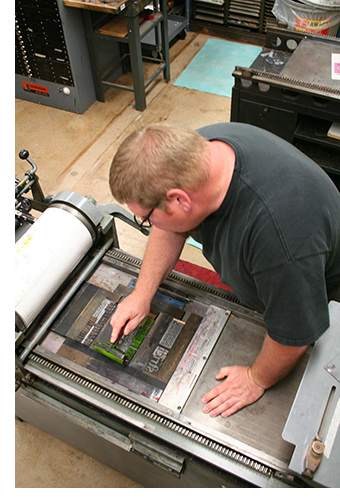| J E F F P U L A S K I | Director and Professor of Graphic Design, School of Art, Design and Creative Industries, Wichita State University |
|
|
In his book A Short History of the Printed Word, Warren Chappell states, “A page of printed type is one of the most abstract pieces of communication I can imagine. Symbols of most ancient origin can be put together in ways that stimulate the eye, through pattern, and the mind, through thought.” I work with type. I work with its form, its meaning and its history. One of the things that distinguish graphic design from other forms of art is the intentional use of type to communicate meaning. This is not to say that type is required for a work to be considered graphic design or that any piece of art displaying type is a piece of graphic design, but we are the only discipline that concerns itself so intently with the use of typography in visual work. I feel that an understanding of type and how to use it effectively is fundamental to the education of every graphic designer. Letterpress excites the typographer in me.
I began working with letterpress when I started graduate school in 2004. I helped to move equipment and type in the letterpress lab at Wichita State and became intrigued and excited by the physicality of the letters. The letterpress lab has been part of the graphic design program since the late 1960s and I feel extremely fortunate to teach at a university where the graphic design faculty saw the value of letterpress a long time ago and protected the materials and equipment. Letterpress is an old technology and its practice today is filled with limitations. You are limited by the materials you have on hand, there are not an unlimited number of fonts with unlimited characters. When you use all the Es you have on hand in a specific font and a specific size, that’s it, there are no more. If you want a word to be slightly larger, you can’t just make it a bigger point size. If a piece of wood type has been abused and has dents and gouges taken out of it, there is very little you can do to change it. The type shows its history of use physically on its face. There are limitations. I like these limitations. These limitations force me to be more creative. They limit the options available to me. The digital tools available today allow designers to create almost anything. Designers are only limited by their individual knowledge of the tools they are using. When the design is finished and printed, a machine spits out perfect copy after perfect copy. Everything is the same. Duplicate images printed on crisp white paper in standard sizes. Letterpress puts the designer back in charge of the process. The medium screams for experimentation. Skill and practice can lead to perfect copies, but variety can also be achieved. I enjoy the tactile nature of letterpress, each element selected and placed in the press bed by hand. Each color printed individually so the image is created slowly, building the overall color as the piece is created. The scars on the type add character. The artist leaves their physical mark on the paper. There is a sense of history to the final piece. This being said, I am not against technology. I love my Mac and Creative Suite software. It is exciting to see 15,000 copies of a piece you created come back from the printer in boxes. Unfortunately, I don’t get to participate in that production process. I have to turn over my files to someone else. I like the act of producing my own work, of controlling my message myself. Letterpress allows me to do that.
|
 Letterpress was the dominant commercial printing process used from the mid 1400s by Gutenberg through the early 1900s. It survived as a viable commercial process until the early 1970s. Basically, it is a relief printing process where a raised surface is inked with a roller and then pressed directly into a piece of paper with significant pressure to transfer the ink. Because the raised surface is pressed directly into the surface of the paper, not only is there a visual result, but depending on the pressure there can be a tactile result also. Much of the material used in letterpress is individual pieces of type cast in metal or cut into wood. These characters made manifest in three-dimensional form are the basis of my attraction to letterpress.
Letterpress was the dominant commercial printing process used from the mid 1400s by Gutenberg through the early 1900s. It survived as a viable commercial process until the early 1970s. Basically, it is a relief printing process where a raised surface is inked with a roller and then pressed directly into a piece of paper with significant pressure to transfer the ink. Because the raised surface is pressed directly into the surface of the paper, not only is there a visual result, but depending on the pressure there can be a tactile result also. Much of the material used in letterpress is individual pieces of type cast in metal or cut into wood. These characters made manifest in three-dimensional form are the basis of my attraction to letterpress.